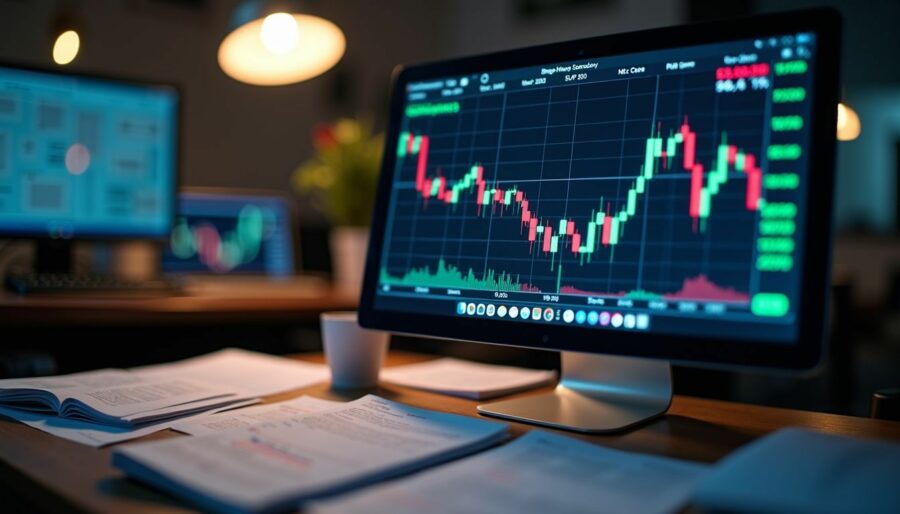September 11, 2024 Top Stocks For Smart Investment Choices
September 8, 2024 S&P 500 In Freefall: Is This The End Of The Bull Market?
September 6, 2024 Jobs Report Spotlight As Fed Weighs Rate Cut Decision
August 26, 2024 NVDA Earnings Report Insights
Apple: Not Ready To Glow Up
Nvidia: The King Of Semiconductor Stocks Is Back – Still Cheap Here
Tesla Robotaxi: Fool Me Ten Times, Shame On Me
Amazon: Oracle Partnership Highlights Margin Expansion Potential
Nvidia: Why You Should Buy Before It Hits $145
April 23, 2024 Maximizing Profits: When is the Right Time to Sell Your Business?
April 12, 2024 Improve Your Financial Status: A How-To Guide
April 12, 2024 How ZIM Integrated Container Tracking is Revolutionizing Global Trade
March 15, 2024 6 Best Growth Stocks To Buy Now According to Metatrader 5
S&P 500 In Freefall: Is This The End Of The Bull Market?
September 8, 2024

The S&P 500’s drop worries many investors. On January 19, 2024, it hit a record high. We will guide you through understanding market trends and preparing for future fluctuations.
Key Takeaways
- The S&P 500 had a strong start in 2024, growing by nearly 20% but then fell by 8.5% in mid-July.
- Global events like Japan raising interest rates and oil price changes affect the S&P 500.
- History shows markets recover from drops, suggesting downturns are temporary phases.
- Smart investing during volatility includes spreading money across different types of assets and keeping some cash ready.
- Long-term investment is advised for growth over time, while short-term strategies can benefit from regular, smaller investments.
Current State of the S&P 500
The S&P 500 is facing a downturn, with recent trends showing a drop. Global economic factors are impacting its performance.
Recent performance trends
Recent performance trends show the S&P 500’s dynamic journey this year. In the early months, it displayed strong growth, marking a nearly 20% increase year-to-date by mid-2024. This index, a gauge for U.S. equities, saw a remarkable rebound, with seven out of eight months posting gains. However, volatility emerged in mid-July, leading to an 8.5% drop by August 5, 2024. Despite this setback, the index recovered, nearly hitting an all-time high by the end of August, showcasing resilience amidst market fluctuations.
| Date | Performance | Note |
|---|---|---|
| Early 2024 | +20% YTD | Strong start to the year |
| Mid-July 2024 | -8.5% | Drop from peak |
| August 5, 2024 | Recovery begins | Down but not out |
| September 1, 2024 | -2% | Minor setback |
| End of August 2024 | Near record high | Resilience shown |
This table breaks down the S&P 500’s recent fluctuations, highlighting its performance in a straightforward manner.
Impact of global economic factors
Global economic factors strongly affect the S&P 500. One major event was Japan’s central bank deciding to raise interest rates in August 2024. This move made borrowing more expensive in the U.S., affecting investor confidence and stock market performance.
Other issues like the Israel-Hamas conflict and the Russia-Ukraine war added uncertainty, making investors nervous.
Oil prices also play a big role. When West Texas Intermediate oil fell to around $60 per barrel, it showed changes in global demand and supply. These shifts impact companies’ profits and therefore their stock prices on markets like Wall Street, involving assets such as the Dow Jones Industrial Average and Nasdaq Composite.
Every investor should watch global events closely as they can change market trends quickly.
Next, let’s discuss potential causes of the downturn.
Potential Causes of the Downturn
Global events and policy changes shake the market. Higher rates and political risks make stocks fall.
Geopolitical uncertainties
Conflicts like the Israel-Hamas fight and the Russia-Ukraine war make markets shaky. These events can scare investors away from equity markets, including the S&P 500. As tensions rise, people worry about how safe their investments are.
This fear can lead to fewer people wanting to buy stocks.
The U.S. presidential elections also play a big part in market mood swings. Investors watch these closely because new leaders can change policies that affect businesses and economy growth rates.
Such changes might be good or bad for the stock market. Knowing this helps investors plan for bull or bear markets ahead.
Rate changes and fiscal policies
The Federal Reserve set the federal funds target rate at 5.25% to 5.50% since July 2023. Before that, it had increased interest rates from nearly zero between March 2022 and July 2023.
This action was of significant importance to investors. It signified that borrowing costs escalated for businesses and individuals purchasing homes or cars.
Investors are now paying scrupulous attention to any indications of interest rate reductions in the Federal Reserve’s mid-September 2024 meeting. A decrease in rates could signify lesser borrowing costs once more, potentially driving stock prices higher.
Grasping fiscal policies and rate alterations is essential for handling market volatility.
Historical Perspectives on Market Corrections
History shows that market drops are part of the cycle. Looking at past bull markets and downturns teaches us about recovery times and resilience.
Duration of past bull markets
Past bull markets last a long time. They show how the stock market can grow.
- The S&P 500 reached a record high on January 19, 2024, with 4,839.81 points.
- Before this, the highest point was on January 3, 2022, at 4,796.56 points.
- It usually takes nearly two years for the market to hit record highs after a downturn.
- This pattern shows that bull markets can recover and reach new highs over time.
- Each recovery period gives investors a chance to see growth in their investments.
- Understanding these cycles helps in planning long-term investment strategies.
- By looking at past bull markets, investors learn about patience and timing in the stock market.
- These insights help diversify asset allocation for better risk management.
This information helps investors stay ready for ups and downs in the market.
Comparisons to previous downturns
To discuss comparisons to previous downturns, we observe market behaviors and outcomes.
| Event | Year | Impact | Recovery Time |
|---|---|---|---|
| Dot-com Bubble Burst | 2000 | Major loss in tech stocks | 2+ years |
| Global Financial Crisis | 2008 | Severe worldwide economic crisis | 4+ years |
| Nasdaq Composite Index fell 13% | 2024 | Market correction | Unknown |
| S&P 500’s worst week | 2023 | Significant drop | Unknown |
This table shows how market downturns have varied impacts and recovery times. Comparing these events helps investors understand current trends.
Strategies for Investors During Market Volatility
In times of market ups and downs, smart moves by investors can make a big difference. Looking at different types of investments and managing risks wisely are key steps.
Diversification and risk management
Diversification and risk management are key for investors in times of market volatility. They help protect investments and can lead to better long-term results.
- Spread investments across multiple asset classes. This means putting money in stocks, bonds, real estate, and alternative investments like hedge funds.
- Consider an equal-weighted S&P 500 ETF. This type of fund gives all companies the same importance, not just the big ones.
- Use defensive stocks to add stability. These stocks, often from utilities or consumer staples sectors, tend to do well even when the economy is not.
- Keep some cash or cash-like assets. Liquidity is important if you need quick access to money or want to grab new opportunities without selling other investments at a loss.
- Limit borrowing to invest. Leverage increases risks during downturns as seen when leverage use led some investors to sell stocks due to borrowing pressures.
- Reassess financial assets regularly but avoid constant changes based on short-term market moves. Stick to a long-term investment approach that matches your risk tolerance.
- Use stop-loss orders if needed to limit potential losses on specific stocks.
- Stay informed about global economic factors that could affect the market but avoid making panic decisions based on news alone.
- Consult with financial advisers who understand diversification and risk management well and can offer personalized advice based on your goals and needs.
- Lastly, keep learning about investment products, asset management, and economic trends that influence market movements.
Long-term versus short-term investment approaches
Long-term investment focuses on holding assets for years. Eric Freedman from U.S. Bank Wealth Management advises choosing long-term assets. This method avoids the stress of market changes and aims for growth over time.
It helps build wealth slowly but surely.
Short-term investment involves buying and selling assets quickly. This approach tries to make money fast from price changes in the market. Haworth suggests dollar-cost averaging for short-term investors with cash.
This means putting money into investments at regular times instead of all at once, reducing risk in volatile markets.
Conclusion
The S&P 500’s recent drop raised fears of a bull market end. Yet, the index hit a record high on January 19, 2024. This shows strength in U.S. stocks, driven by tech gains and rate cut hopes.
Experts see this as a chance to buy long-term assets. With possible interest rate cuts and ongoing economic growth, the bull market seems secure for now.
FAQs
1. What is the S&P 500 and why is it in freefall?
The Standard & Poor’s 500, or S&P 500, consists of the largest publicly traded companies in the U.S. economy. Its current freefall could be due to various factors such as changes in economic data, corporate earnings, or stock valuations.
2. Does a falling S&P 500 mean an end to the bull market?
A falling S&P 500 does not necessarily signal an end to the bull market. It depends on other factors like GDP growth, unemployment rate, wage growth and federal reserve system policies including interest rate cuts.
3. How might this impact my investments with J.P Morgan Private Bank?
Investments managed by entities like JPMCB and JPMS under J.P Morgan Private Bank could be affected by fluctuations in the S&P Dow Jones Indices rates of return.
4. Can artificial intelligence (AI) predict these market trends?
Yes, AI can analyze macroeconomic indicators like price-to-earnings (P/E), over-the-counter (OTC) trade volumes and credit conditions to forecast potential bubbles or crashes.
5. What role do central banks play during a market crash?
Central banks like Bundesanstalt für Finanzdienstleistungsaufsicht (BaFin) or German Central Bank may implement measures such as loan guarantees and mortgage adjustments to stabilize their respective economies amid recessions.
6. How can I protect my investment portfolio from these risks?
Diversifying your investments across different asset classes through separately managed accounts or exchange-traded funds can help mitigate risk during periods of low annual returns.















